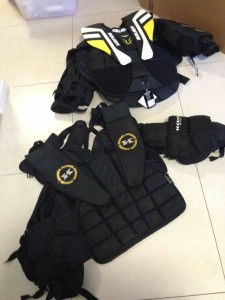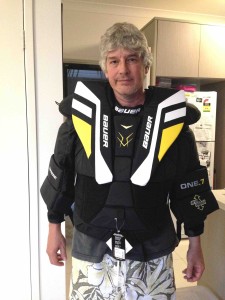Maybe all that Zamboni CO got to me when I was a kid spending hours at the hockey arena.
 I used to think I was fast enough to not worry too much about upper body padding.
I used to think I was fast enough to not worry too much about upper body padding.
I’m not fast enough anymore.
I played my first game in 10 years on Sunday, except for one in Guelph and one last year in which I let in 12 goals on what felt like 70 shots, and ripped my ACL.
We lost 3-1, but were outshot 22-10. I did OK. The team did great (I also coach this bunch of adults, and like any good coach, just want to see continuous improvement and having fun – and sweat).
In fortuitous timing, my fab partner Amy ordered me an early Xmas present which arrived today.
 This is my 20-or 30-year-old chest protector, this is my new one.
This is my 20-or 30-year-old chest protector, this is my new one.
And this is my happy face.
But public health takes place at the arena too.
The U.S. Centers for Disease Control reported last week that on December 13, 2014, the emergency management system in Lake Delton, Wisconsin, was notified when a male hockey player aged 20 years lost consciousness after participation in an indoor hockey tournament that included approximately 50 hockey players and 100 other attendees.
Elevated levels of carbon monoxide (CO) (range = 45 ppm–165 ppm) were detected by the fire department inside the arena. The emergency management system encouraged all players and attendees to seek medical evaluation for possible CO poisoning.
 The Wisconsin Department of Health Services (WDHS) conducted an epidemiologic investigation to determine what caused the exposure and to recommend preventive strategies. Investigators abstracted medical records from area emergency departments (EDs) for patients who sought care for CO exposure during December 13–14, 2014, conducted a follow-up survey of ED patients approximately 2 months after the event, and conducted informant interviews. Ninety-two persons sought ED evaluation for possible CO exposure, all of whom were tested for CO poisoning. Seventy-four (80%) patients had blood carboxyhemoglobin (COHb) levels consistent with CO poisoning (1); 32 (43%) CO poisoning cases were among hockey players. On December 15, the CO emissions from the propane-fueled ice resurfacer were demonstrated to be 4.8% of total emissions when actively resurfacing and 2.3% when idling, both above the optimal range of 0.5%–1.0% (2,3). Incomplete fuel combustion by the ice resurfacer was the most likely source of elevated CO. CO poisonings in ice arenas can be prevented through regular maintenance of ice resurfacers, installation of CO detectors, and provision of adequate ventilation.
The Wisconsin Department of Health Services (WDHS) conducted an epidemiologic investigation to determine what caused the exposure and to recommend preventive strategies. Investigators abstracted medical records from area emergency departments (EDs) for patients who sought care for CO exposure during December 13–14, 2014, conducted a follow-up survey of ED patients approximately 2 months after the event, and conducted informant interviews. Ninety-two persons sought ED evaluation for possible CO exposure, all of whom were tested for CO poisoning. Seventy-four (80%) patients had blood carboxyhemoglobin (COHb) levels consistent with CO poisoning (1); 32 (43%) CO poisoning cases were among hockey players. On December 15, the CO emissions from the propane-fueled ice resurfacer were demonstrated to be 4.8% of total emissions when actively resurfacing and 2.3% when idling, both above the optimal range of 0.5%–1.0% (2,3). Incomplete fuel combustion by the ice resurfacer was the most likely source of elevated CO. CO poisonings in ice arenas can be prevented through regular maintenance of ice resurfacers, installation of CO detectors, and provision of adequate ventilation.
